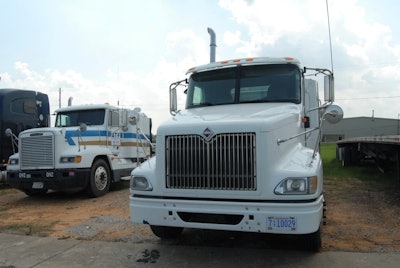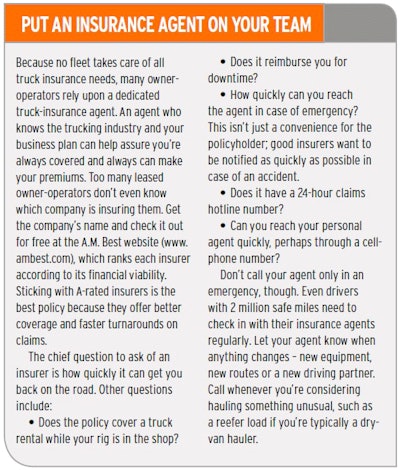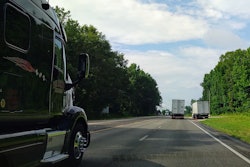Understand the types of coverage and what your operation requires.
After the truck payment, truck insurance is an owner-operator’s biggest fixed cost, one that must be paid on time whether a truck is running hard or parked. Without adequate insurance, an accident or cargo claim could mean financial ruin.

THE COST OF PROTECTION
Insurance expenses can add up quickly, which is why many owner-operators budget their premiums a year ahead. Your age, your driving record, the age and condition of your equipment, the commodities you haul, the lanes you run and state requirements all affect insurance costs, but an owner-operator with a new truck and his own authority is likely to pay:
• $6,000 or more a year for $1 million in primary liability insurance. This covers damage or injury done to others in an accident.
• $3,000 a year for physical damage insurance. This covers damage done to your truck and trailer in an accident.
• $1,000 a year for cargo insurance. This covers damage to or theft of the load you’re hauling.
• $630 a year for $1 million in nontrucking-use liability insurance. Often called “bobtail insurance,” this covers damage or injury done to others in case of an accident while you’re not under dispatch.
All that insurance totals almost $11,000 per year, assuming a safe driving record. Cited speed demons can pay much more.
Leased owner-operators generally carry just as much truck insurance but pay for less of it themselves. The leased operator should make sure the lease agreement specifies what he is not responsible for, typically primary liability and cargo insurance, and what he is responsible for, typically physical damage and nontrucking liability insurance. Some fleets charge the owner-operator for primary liability and cargo insurance, usually by taking a percentage of all settlements, but other fleets absorb it as part of the cost of doing business.
Owner-operators shopping for insurance can look to trucking-specific insurance agencies or truck dealers – or buy direct from the insurance company itself. Shop around before you buy, looking for the most coverage at the most reasonable cost. Some leased owner-operators buy all their insurance independently of the plans offered by their fleets. This costs more in most cases, but its advantages include more control of your coverage, a closer business relationship with your agent, and a speedier reply when you have an emergency. Better yet, independently purchased insurance is portable, so if you and your fleet part ways, you’re still covered en route to the next orientation. Before you can be assigned a load, you’ll have to show your carrier proof you have all the coverage it requires.
LIABILITY INSURANCE
If you are operating under your own authority, you are required by federal law to have a minimum of $750,000 liability coverage. This is to protect you in a major accident in which you are at fault. You may want to consider higher coverage, $5 million or more, since a catastrophic truck accident can cost many millions of dollars.
Because primary liability insurance is the law, it’s standard in lease agreements. Remember, though, that just because your carrier is insured against damage you cause, it won’t necessarily be on your side in case of an accident. For that reason, some leased owner-operators opt to buy liability insurance independently of their carriers.
For most, however, having liability taken care of is one of the biggest advantages to leasing. Owner-operators who switch to their own authority often are surprised by how costly, complex and time-consuming liability coverage can be, particularly when starting up a first-time business. While a damage policy commits the insurer to paying only the current value of the truck, a typical primary liability policy commits the insurer to paying as much as $1 million if something goes wrong. Moreover, the insurance industry considers owner-operators to be higher risks than fleets, and that earns the insurer only about $6,000 a year in premiums.

DAMAGE INSURANCE
The law does not require physical damage insurance, but lenders do. A damage policy will pay no more than the value of the equipment at the time of the accident. In other words, you won’t get a new truck out of a damage claim, even if your present truck is totaled. The insurer’s preference always is to go the cheapest route, which usually is repairing the truck you have. At best, you’ll get enough to buy another truck of the same age and mileage.
A typical damage premium is anywhere from 3 percent to 5 percent of the truck value, or $3,000 to $5,000 for a truck worth $100,000. A bad driving record, however, can bump the cost to $8,000 a year or more – if you still can get damage insurance at all. If you buy damage insurance from a truck dealer financing your truck, your truck payments are higher, and your interest costs go up. It may be less expensive to get insurance through an independent agent.
Make sure that damage policies don’t count the cost of towing as part of a settlement. If they do, thousands of dollars of any settlement will go not to repairs but to the tow company. You’re better off getting extra coverage for towing.
GAP INSURANCE. Since an owner-operator can owe more on a truck than it’s actually worth due to depreciation, a damage settlement may not be enough to make the rest of the payments on the totaled rig. If you’re driving a new truck or a used truck not more than five or six years old, gap insurance might be helpful. It covers the difference between the actual book value of the truck and what you owe on the truck. If the market value of your truck is $40,000, but you have a loan balance of $50,000, you would be short $10,000 to pay off the loan in the event your truck was totaled. Gap coverage would make up the $10,000 shortfall.
DAMAGE DEDUCTIBLES. Besides the premium, the other important number in a damage formula is the deductible. A deductible of $1,000 means the policyholder agrees to pay the first $1,000 of expenses before the insurance kicks in. The higher the deductible, the lower the premium.
Ask your agent for a range of prices at various deductibles, low to high. Deductibles of $1,000 are typical. A top-of-the-line rig may have deductible options as high as $10,000. Low to moderate deductibles, however, are the best choices for an owner-operator. A high deductible is no bargain if an accident puts you out of business. If the deductible in your fleet policy is too high for comfort, you even can buy insurance that will pay that deductible for you. Such “deductible buyback” insurance generally is cheap.
COVERAGE OF OTHER EQUIPMENT. Any truck equipment not covered in a basic damage policy – for example, auxiliary power units, tarps, binders, chains – can be added by the owner-operator at minimal cost. A basic damage policy likely won’t cover the cost of replacing a tank full of diesel that spills in an accident, or any other fluids that need replacing afterward. Boilerplate damage policies typically cover only permanent manufacturer-installed fixtures on the truck, not any extras added later such as Qualcomm, Vorad or satellite radio. All can be covered for a small fee, but the insurance company has to know the items are there.
CARGO INSURANCE
The federal government ended its requirement for $5,000 in cargo coverage for interstate carriers in 2011, but shippers are expected to continue to require it of carriers hauling their freight, and carriers will require it of leased operators. Fleets typically buy $100,000 on the owner-operator’s behalf, which is the amount mandated by many shippers. Specialty haulers can carry far more.
The fine print in some lease agreements charges the owner-operator for any cargo losses if he’s at fault in an accident, cargo insurance or no cargo insurance. Some loads have a much higher monetary value than an owner-operator’s cargo insurance can cover. Yet owner-operators often don’t know who’s liable for the difference if an expensive load is lost. Read your policy, and find answers to these questions before an emergency occurs.
NON-TRUCKING-USE LIABILITY INSURANCE
The name of this insurance, which covers you when you’re not under dispatch, is a more precise term for what used to be called “bobtail insurance.” The meaning of “under dispatch” sometimes has to be determined in courtrooms. Courts have held that even a bobtail trip home can be considered under dispatch, since the route is determined by where the fleet most recently sent the driver.
Sometimes the fleet’s insurance company refuses to pay a claim, arguing the owner-operator was not under dispatch at the time, and the owner-operator’s insurance company likewise refuses to pay, saying he indeed was under dispatch. In these cases, the owner-operator is caught in the middle and needs a good lawyer himself.
Most carrier leases require nontrucking-use liability coverage. The cost is typically $50 or more per month.
REIN IN THOSE PREMIUMS
Here are some good business practices that help put the brakes on premium increases.
DRIVE CAREFULLY. A professional driver must drive professionally at all times, no matter the vehicle. A speeding ticket in your personal vehicle will increase a truck-insurance premium and dissuade some insurers from doing business with you. Even minor offenses – including minor vehicle inspection violations now that the Federal Motor Carrier Safety Administration’s Compliance Safety Accountability program is in effect – stay on your record for years; major offenses will stay as long as you live.
TAKE A BITE OUT OF CRIME. Be especially cautious when hauling cargo that attracts criminals, such as cigarettes, cell phones or designer clothes. Park only in lighted secured areas, and don’t leave a truck or trailer unattended over a holiday weekend.
KEEP VALUES, ESTIMATED MILEAGE CURRENT. Talk to your insurance agent every year to adjust your physical damage coverage according to the changing value of your equipment. Usually this means depreciation, but that value can go up, too. Prices for liability insurances are based on estimated exposure, i.e. the miles you run annually and where you run them. Insurance companies with automatic renewal programs aren’t getting updates about the reality of your business since you started the contract. Talk to them early and often if the freight you’re hauling, your region or your miles change significantly. Some insurers, following the auto market, envision more direct and frequent rate updates in the future, as access to real-time mileage via GPS-enabled onboard computing units is made available.
DON’T OVERINSURE. Being overinsured often means duplicate coverage somewhere, such as a private policy that overlaps a fleet policy. But some owner-operators just buy too much coverage. A driver running back roads within a 100-mile radius of the yard who carries $3 million in liability insurance is paying for three times more than he needs. Keep in mind, though, that having too much insurance is better than having too little, which can put you out of business.
WATCH THOSE LUMPERS. Don’t leave your cargo and your trailer to the mercy of lumpers and dockworkers you don’t know. Keep an eye on what’s going on to make sure nothing’s damaged or taken.
KNOW YOUR CARGO. Read the bills of lading. Ask questions of your dispatcher or freight broker to find out exactly what you’re hauling and for whom in case it’s more than your cargo policy will cover. Also make note of any already damaged cargo at pickup, and make the shipper or fleet sign off on it so you aren’t blamed later.
KEEP UP YOUR PAYMENTS. Insurance is a fixed expense – one you should budget a year ahead. Skipping insurance payments is a poor way to save money. If you let your insurance lapse, you’ll pay the penalty for years to come in higher premiums – even if you can find an insurer to cover you.
REPORT ACCIDENTS IMMEDIATELY. Tell your insurance company within the hour if possible. Don’t rely on the police to do it. Days after the fact, all the unhappy insurer has to go on is the police report, and other parties involved in the incident have had plenty of time to call lawyers.
KNOW YOUR POLICY. Know what’s covered and what isn’t. Rather than paying for a laundry list of extra items your basic policy doesn’t cover, your best buy may be a comprehensive/collision policy that lists only the few things not covered, such as rodent damage or normal wear and tear.
SHOP AROUND. For cost and convenience, leased operators should begin their shopping with the fleet program. But if your fleet bundles physical damage, liability and cargo insurance, you might try “unbundling” it, as physical damage alone sometimes can be bought independently more cheaply.
IMPRESS YOUR INSURER. Demonstrate that you’re a safe, stable and responsible businessperson with a desire to keep your claims to a minimum. Insurers want to see a clean motor vehicle record, newer equipment and years of experience – especially with the same carrier. If your truck is older, share your detailed maintenance and service plan.









